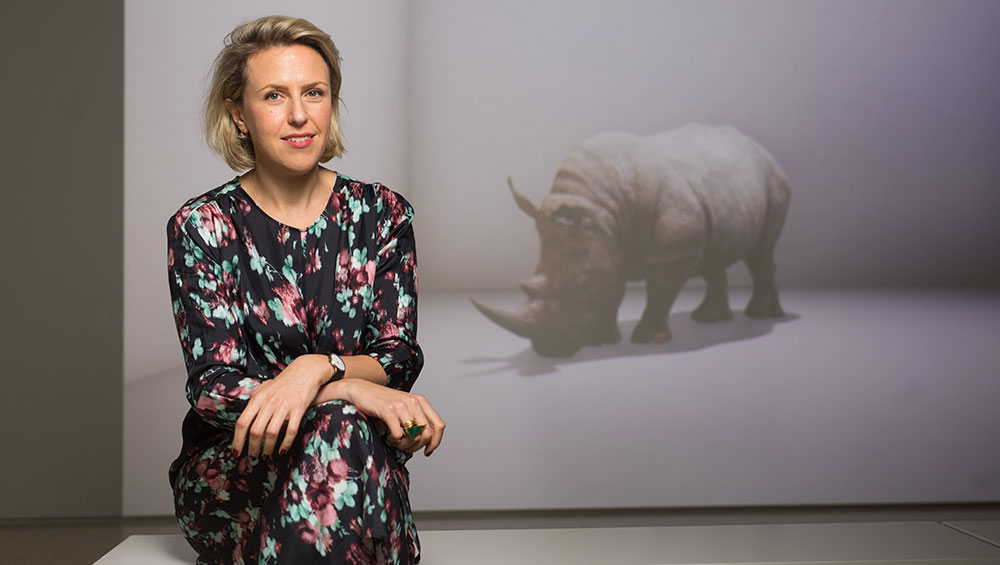
by VERONICA SIMPSON
Alexandra Daisy Ginsberg (b1982, London) is very much an artist for the Anthropocene age. Her multifaceted investigative installations incorporate CGI, sound and game design, sculpture, architecture and a multitude of sciences to examine where our faith in man- and machine-made solutions has brought us, and where it could take us as a species.
Her subject matter ranges from planets – she proposed the wilding of Mars, very much without the toxic impacts of human colonisation, for London’s Design Museum’s Moving to Mars, earlier this year– to the technological reincarnation of extinct animals (The Substitute, for the Royal Academy’s Eco Visionaries exhibition, which ended in February) and the revival of plant species via synthetic biology (Resurrecting the Sublime, various exhibitions).
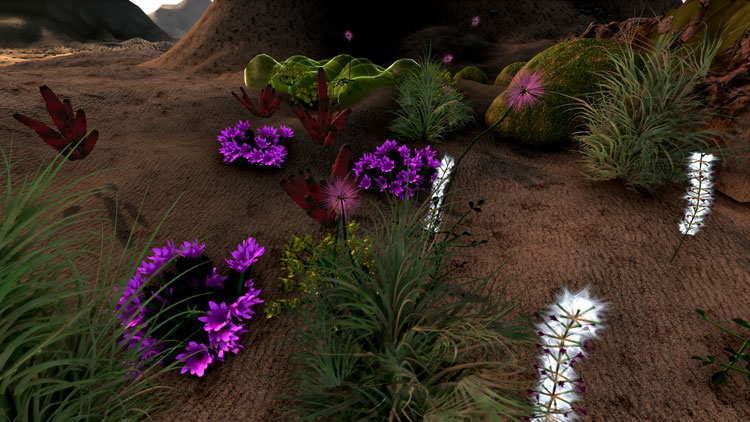
Alexandra Daisy Ginsberg. The Wilding of Mars, simulation shot, Moving to Mars, The Design Museum, London, 2019. Photo: © The Design Museum, Ed Reeves.
Machine Auguries, her installation evoking the decimating impact of urban noise on bird populations, commissioned by Somerset House, London, for its recent 24/7 exhibition, was exhilarating and deeply discomfiting, as the sound of a real dawn chorus emerged from speakers placed high in the room, to be interwoven with a robotically replicated version created via an advanced artificial intelligence programme.
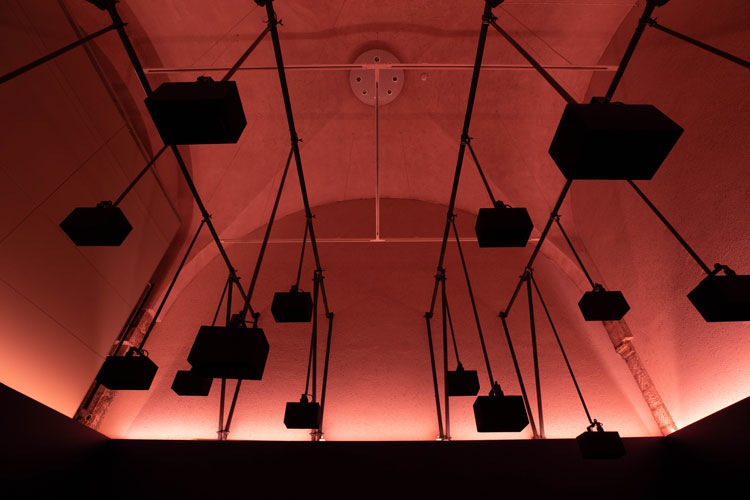
Alexandra Daisy Ginsberg. Machine Auguries. Commissioned by Somerset House for the 24/7 exhibition (October 2019 to February 2020), Machine Auguries comprises a genuine dawn chorus of birdsong that is eventually taken over by artificial birdsong. Heard from speakers placed close to the ceiling against a backdrop of coloured light that emulates the dawn spectrum. © the artist.
An alumnus of the Royal College of Art’s legendary design interactions master’s (launched in 2005, it closed in 2015 after its founders, Anthony Dunne and Fiona Raby left the programme), her work has evolved significantly since she completed a PhD, also at the RCA, in 2017. From the speculative provocations around synthetic biology of 2009 to 2015 to the more recent multisensory and multidisciplinary installations, her practice has moved firmly into the art arena, helping to expand the debate around our prevailing Anthropocene fixations. It has done so thanks to the profound impact the works have, visually, intellectually and emotionally. Her work, she tells us, seeks to evoke a “sense of anxiety and loss and beauty … mixed together to create a certain reaction”.
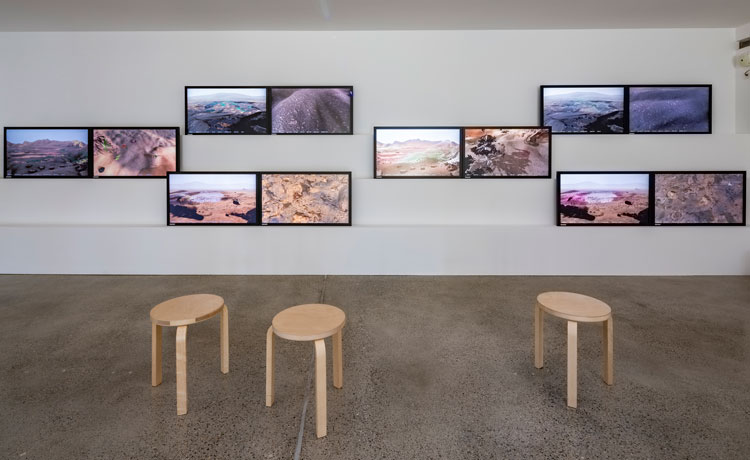
Alexandra Daisy Ginsberg. Better Nature, installation view, Vitra Design Museum Gallery, 2019. Photo: © Vitra Design Museum, Bettina Matthiesen.
The last two years have been extremely productive, with her installations appearing in 2019 at a multitude of exhibitions in leading international museums and galleries, as well as cultural festivals (including Broken Nature, at the Milan Triennale and the Saint-Étienne Design Biennale), and culminating in her solo exhibition Better Nature, at Vitra Design Museum. Her 2020 calendar had looked set to continue that trajectory, with 10 museum or gallery shows scheduled, some of which had already opened - such as Survival of the Fittest at the Kunstpalais in Erlangen, Germany, Apocalypse – End Without End at the Natural History Museum in Bern, Switzerland, and the Eden Project’s Radical Botany, in Cornwall. But as the museum and gallery worlds shut down in March 2020, her schedule collapsed. As we spoke, she was contemplating the prospect that her invitation to show at the Venice Architecture Biennale, in its postponed August slot, could be the main event in her 2020 calendar.
Veronica Simpson: These are very troubled and worrying times for everyone, but the culture sector is going to find it particularly hard to recover.
Alexandra Daisy Ginsberg: With ticket sales down, the whole industry will be hit. I don’t see how many practices will survive, and if there are no commissioning budgets for next year, ramifications will continue. I don’t know how our sector deals with this. I have a studio of five and it’s not going to look the same very soon.
More important than this, however, is what world will be rebuilt? That’s how I would like to start this interview. That’s the optimistic angle on all of this. We’ve had to radically change our lifestyles in a matter of weeks and there is an opportunity to say how do we radically continue to change our lifestyles … How do we make sure we don’t rebuild the same world?
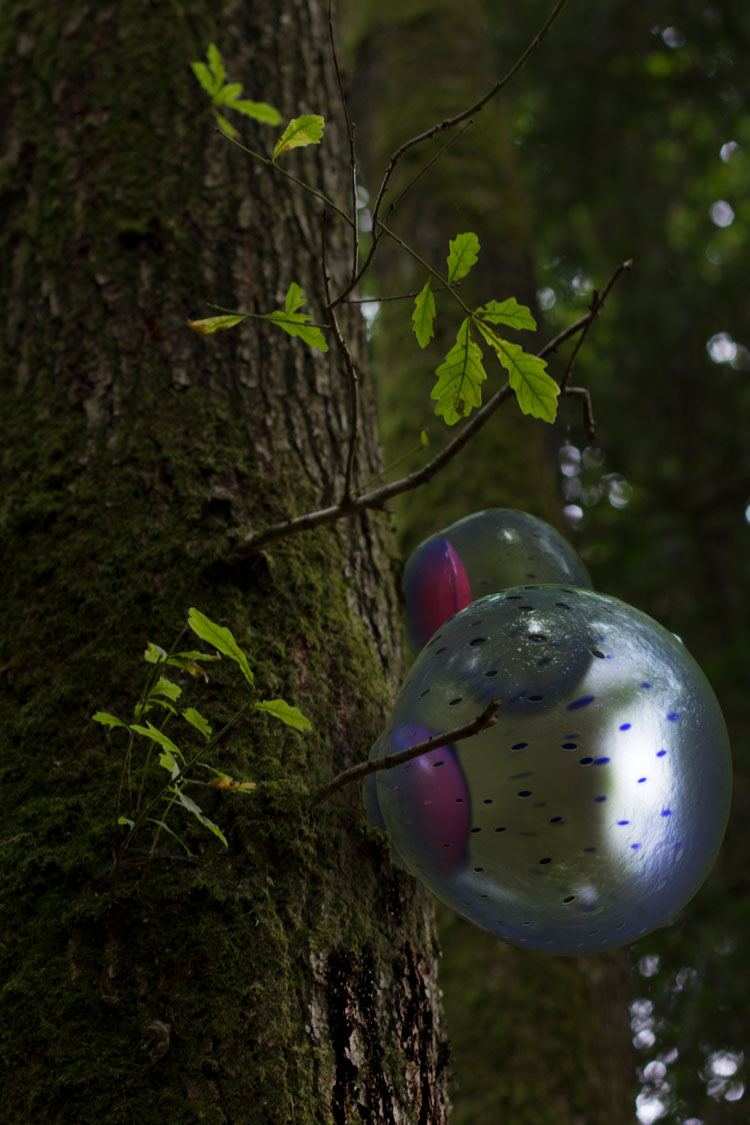
Alexandra Daisy Ginsberg. Self-inflating Antipathogenic Membrane Pump. Designing for the sixth extinction, 2013. Commissioned for the Grow your Own … Life After Nature exhibition at the Science Gallery, Dublin. Ginsberg speculated on a future landscape where synthetic biologists have redressed the damage of 20th and 21st century pollution via invented creatures that would exist alongside endangered species, in order to support them. © the artist.
The theme of the Venice Biennale – How will we live together? – took on a new meaning with all of this. Now, it is about how will we live together, apart? That question is so important. Many of the ways we live together don’t function. And when we live together with other species, we definitely don’t function. We need to radically rethink our behaviours, globally. This coronavirus is horrific in terms of the devastation it’s going to wreak on people’s lives. The question is: what happens next? It’s a one-year state that we’ll be stuck in. What can we do now, while we are all in this together, to plan differently, while we are forced to. And how do we look after each other because the structures we expected to be in place might not survive.
VS: Let us hope that this gives us a chance to reshape our future into something better. Speaking of which, you have had an extraordinary few years since finishing your PhD, also titled “Better”. Looking at the number of exhibitions you have been in over the last 18 months, and the shift in the quality and kind of work you have produced, where did that drive and momentum come from?
ADG: In 2017, I felt no excitement about my work. The PhD was so hard. And the RCA was going through a very difficult time. The design interactions course closed while I was doing my PhD, which made it much harder to be able to practice work I wanted to do … I have been involved in synbio (synthetic biology) since 2008. It was initially a critical space for artists and designers to work within, but as the field solidified and industrialised it became much more instrumentalised, and the kind of thing we saw emerge was the [education programme and competition] Biodesign Challenge.
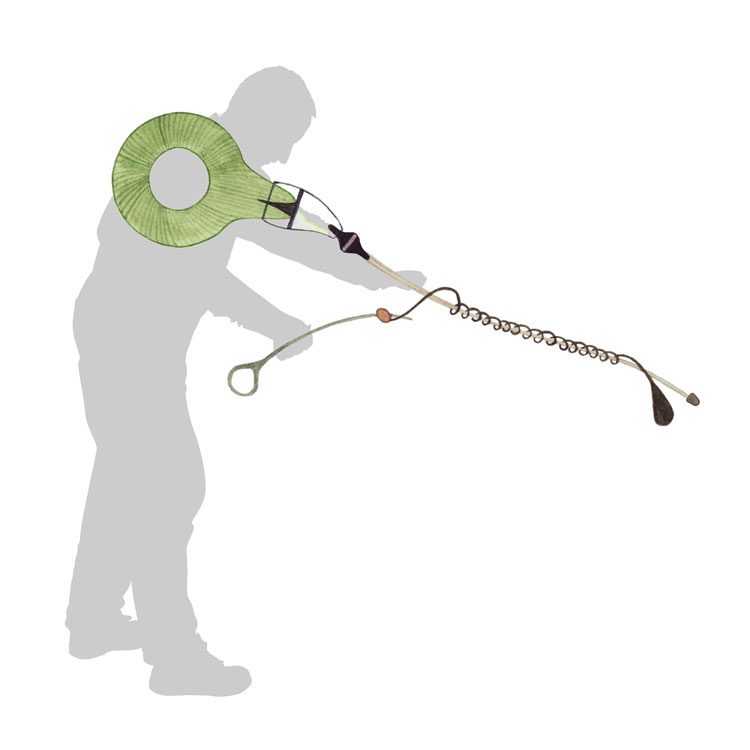
Alexandra Daisy Ginsberg. Assembled Herbicide Sprayer with Man, 2009. Growth Assembly was one of Ginsberg’s final projects for her MA in design interactions, at the Royal College of Art. It proposed that, instead of identikit tools made by machines, we could grow our own, using particular plants. It suggested a plant spray made from seven individual components grown by different species. © the artist.
What I looked at in my PhD research was how people in synbio were constructing different visions of better around their own belief systems and how what they proposed reflected their own values. I finished by making a heavy analysis of biodesign and looking at how artists and designers were colonising the synthetic design space. I wanted to position myself quite differently from that.
VS: Do you think that moving more firmly into the art space and calling yourself an artist has given you more freedom?
ADG: I feel like I’m an artist, although I really enjoy operating within the design world. It is a shame there is such a boundary between art and design. Occasionally, you see crossovers, but there is very strong delineation. They are essentially two different universes. It is very hard to cross that boundary in terms of all sorts of different economies. But it feels quite freeing to not have to defend a position of being a designer who doesn’t solve anything. I think design is an optimistic activity, but art doesn’t have to offer solutions.
The way the design world operates is about products. I’m not doing design thinking or service design. It feels easier to explain my situation as an artist who is interested in design - although it has shifted, with my environmental concerns, to being an artist interested in nature.
I am not seen as a typical artist because my studio is more like a typical design practice. I like working with teams; my projects are very collaborative.
VS: Do you think that collaborative approach – and your scientific rigour – comes from your training as an architect? After all, you studied architecture at Cambridge to BA level. And yet you abandoned architecture after four months in practice. What was it that didn’t agree with you, or that you didn’t agree with?
ADG: I saw an incredibly troubled discipline and decided that what I was interested in was design - not how you design a building, but the ethics of design practice. That remains. I want to understand questions like: how did we get ourselves in this pickle? How do we get ourselves out? And thinking about our relationships with the natural world, our relationships with technology as part of the problem.
However, I think it’s such a fantastic degree and I don’t regret doing it. It gave me a rigour and a way of thinking at different scales. In Cambridge, in particular, you get this incredible history and theory bombardment. I am so fortunate to have done that. Actually, the whole team in the studio has studied architecture to master’s level. I picked them because I knew we were building installations and they would have the skills to be versatile. It is funny that when I go to (synbio and biodesign) events, I realise how many people there studied architecture and are not architects. There are lots of escaped architects out there.
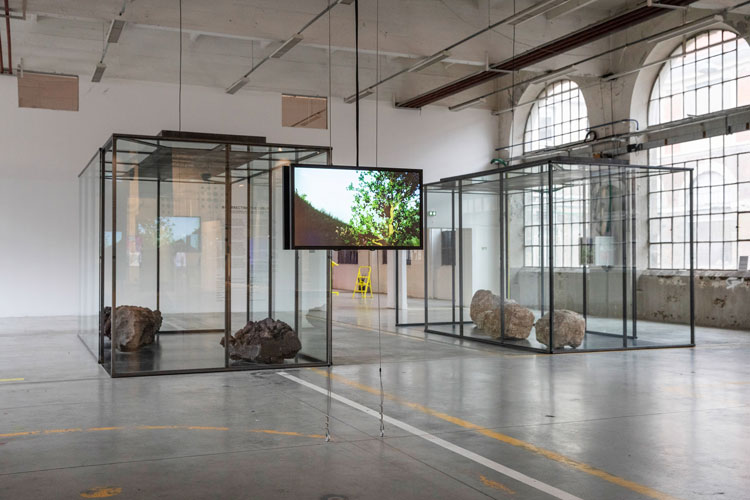
Alexandra Daisy Ginsberg. Resurrecting the Sublime, Saint-Étienne Design Biennale, 2019. A collaboration with Christina Agapakis of Ginkgo Bioworks and Sissel Tolaas. Photo: © Pierre Grasset.
VS: When I first met you, in 2014, you had just embarked on your PhD, but already you were worried about the influence that scientific funding was having within synbio - that the scientific community’s sudden enthusiasm for design collaboration would mean your mission would be co-opted by the strings that invariably come with scientific research grants.
ADG: There were problems I was encountering around public engagement, and that the end goal with science and synbio was more towards public acceptance than engagement. A lot of what I had characterised to scientists and myself as scientific engagement was around bringing society into science. So, for me, one of the vows I made after my PhD was setting myself up in a cultural institution to see if that made it easier. I have worked with scientists over the last few years, but the relationship has been different. Working with Ginkgo Bioworks on Resurrecting the Sublime was brilliant; I was able to work towards a narrative that I was really pleased with – it wasn’t about synbio, it was about flowers, about extinction and biodiversity loss. (Resurrecting the Sublime was a collaboration with Christina Agapakis, the creative director of the biotechnology company Ginkgo Bioworks, and the smell researcher and artist Sissel Tolaas, the idea being to resurrect the scent and stories of flowers driven to extinction by human endeavour. Agapakis used synthetic biology to extract tiny amounts of DNA from specimens of three particular extinct flowers stored at Harvard University’s herbaria, and Tolaas recreated the likely scent, based on the same or similar molecules identified from the DNA).
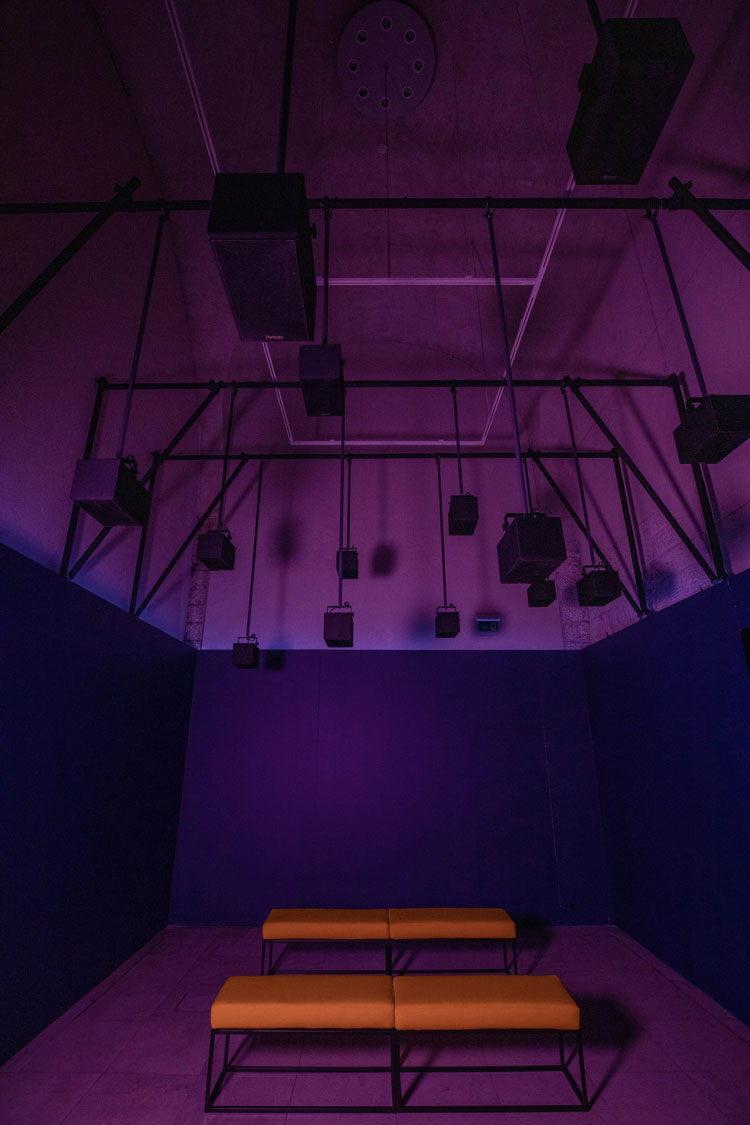
Alexandra Daisy Ginsberg. Machine Auguries. Commissioned by Somerset House for the 24/7 exhibition (October 2019 to February 2020), Machine Auguries comprises a genuine dawn chorus of birdsong that is eventually taken over by artificial birdsong. Heard from speakers placed close to the ceiling against a backdrop of coloured light that emulates the dawn spectrum. © the artist.
VS: You seem to relish delving into new scientific and technical arenas with each project. Tell me how Machine Auguries evolved?
ADG: Somerset House wanted us to come up with something about the effects of non-stop life on our bodies and ourselves. I asked if we could think about other species. I had not realised how much birds are affected by humans. Noise and light pollution levels stop them from being able to communicate. Birds sing as a way to communicate with each other, find their mates and defend their territory. They are now singing louder, longer and at a higher pitch to combat noise pollution, and expending more energy to do so. This has impacts for bird populations and diversity. In the US, the bird population has declined by 30%. We decided to build a new dawn chorus and look at how birds learn from each other. We built thousands of artificial birds and put them into a dawn chorus. We start with a real redstart and the machine sings back. By the middle of the piece, machines have taken over, and, by the end, a few real birds start to come back but it’s hard to tell which is which. You leave, I hope, feeling ambiguous. I want people to ask themselves: how do we do better by nature?
VS: What your work seems to do so well is mine that uncomfortable ethical terrain around what is real and what we can create artificially, through CGI or AI. Do you worry that the seductions of these beautifully realised fictions play too strongly to our almost childish belief that technology can solve all our problems – which you clearly don’t believe?
ADG: I play with beauty. I’d like to think all my work is beautiful. I play with aesthetics, especially in the more recent works. There is a strong frame of reference to the history of art and landscape. I am playing with tropes we recognise and know and finding this uncomfortable line. There is this sense of anxiety and loss and beauty and things mixed together to create a certain reaction. Resurrecting the sublime is an intensely aesthetic experience. It’s like a zen garden, just rocks and nothing else.
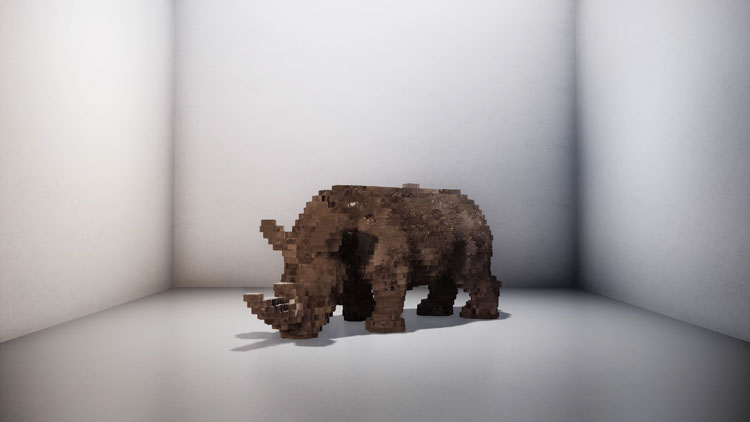
Alexandra Daisy Ginsberg. The Substitute was commissioned by the Cooper Hewitt museum in New York. Using CGI animation, Ginsberg conjures the extinct northern white male rhino back to life on a 5-metre screen, while a second screen reveals the learning process of an AI tool, DeepMind, which replicates the mammalian brain’s ‘grid cell’ navigational patterning. © the artist.
With The Substitute, that plays very much with hyperrealism and using the tools to give us a sense of intimacy and the different kind of experience you would have, for example, on a Hollywood blockbuster. I was working with animators who wanted to push it in all sorts of other directions, to make the landscape more realistic. I said: “No, we are putting it in a white box.”
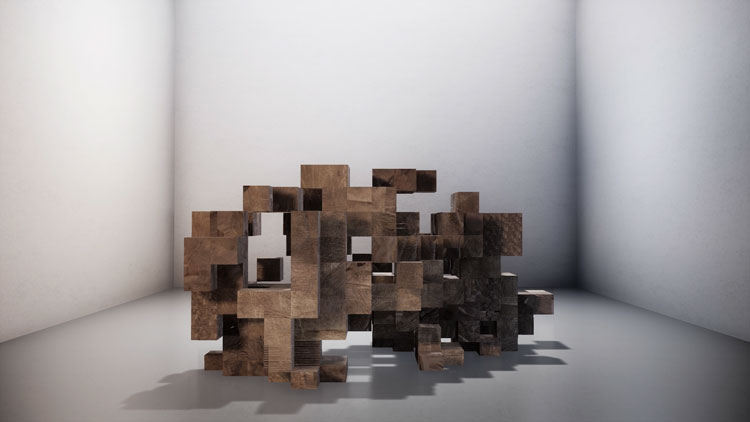
Alexandra Daisy Ginsberg. The Substitute. CGI animation. © the artist.
VS: I really enjoyed that work, though I was a little disappointed by the Eco-Visionaries show, knowing that there are plenty of people working in the field of design and architecture who really are trying to address the ecological issues we face, and yet the exhibition was largely dystopian.
ADG: I was really surprised by some of the reviews. I was asked to talk about the role of the artist in the environmental crisis. What insights can we give? I said I don’t have a clue. I don’t have any solutions. Why are we expecting artists and designers to come up with solutions? There are solutions (we can find) as citizens, and solutions that we demand for dramatic change. The Times reviewer wrote about my work, saying: “Ginsberg has no answers.” And that’s my mantra now. I can contribute as an individual, and as a citizen, we can all contribute.
VS: We were both at 2018’s Beirut Design Week seminar, and there you mentioned the Futurama exhibition that Norman Bel Geddes organised (for General Motors, as part of the World’s Fair in New York in 1939-40), showcasing all the ways in which technology would make our lives better. You suggested that we need a new Futurama exhibition. Do you still think that?
ADG: I don’t know. What I really struggle with is that some of the technology I have worked with in the last year, such as the AI tools, are eminently seductive. You play with these tools and it is incredible what you can do. To watch a system learn and grow is amazing. Then you think how much money it would take to save a species and you have to ask yourself - what are we doing? AI can be used for good. And it can help us run our lives more smoothly. But, for me, the reckoning is social and ecological. I went to the [UN Climate Change Conference] COP25 in December 2019. I seriously hope the IUCN (International Union for Conservation of Nature) World Conservation Congress happens in June. [Since this interview took place, the congress has been postponed until January 2021.] To see the mechanisms of global governance in action is terrifying because you realise how hard it is to get people on the same page. Our interests are different… that’s where some of the actions around Extinction Rebellion are really interesting. There is a lot of critique around them, but what has been incredible is watching people I wouldn’t have expected to be interested in environmental issues emerge who are cognisant and wanting to do their part. A Futurama, if it were to happen, would not be around technological innovation.
I think we need to be more aware than ever now that art and the cultural sector is essential to civilisation and keeping that going is vital. It is non-expendable. We are going to have to really pull together as an industry, if we can call ourselves that, to find ways round the impacts of the current global lockdowns.